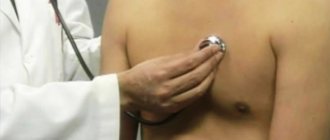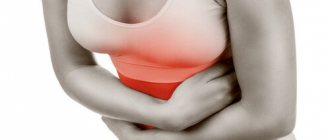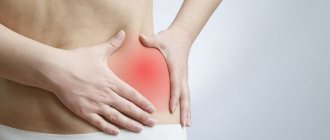Causes of heaviness in the sternum
The appearance of heaviness in the sternum can be caused by a number of different diseases and differ slightly in symptoms.
Most often accompanied by additional symptoms:
- belching;
- difficulty breathing;
- feeling of discomfort after eating;
- cough;
- lump in throat;
- shortness of breath.
Spasms that cause pain appear against the background of:
- injuries;
- inflammatory process in internal organs;
- damage to nerve fibers;
- stress;
- chronic fatigue.
The nature of the pain, depending on the disease, can be pulling, girdling or pressing. In addition, it differs in localization, intensity and frequency. Also, tension in the chest area can be accompanied by cramps, nausea and vomiting. Discomfort increases after heavy physical work, eating and taking a deep breath.
Symptoms
If heaviness in the chest area is caused by pathological reasons, it is always accompanied by other symptoms that can be used to make a preliminary diagnosis. In heart diseases the following are observed:
- burning behind the sternum;
- dyspnea;
- sudden increase or decrease in heart rate;
- feeling of lack of air;
- numbness of fingers;
- panic and severe fear (with myocardial infarction).
Often we have to deal with atypical forms of pathologies. This makes diagnosis very difficult and can even cost a person his life. For example, with myocardial infarction, vomiting, stomach pain, and diarrhea sometimes appear.
Types of diseases that cause heaviness in the sternum
Heaviness in the sternum, in the middle, pressing and intense, can appear due to various diseases.
These include:
- Spasms of the esophagus caused by viral or fungal infections, poisoning or damage to the mucosa. Often accompanied by difficulty swallowing.
- Injuries to the chest or internal organs, pain in which radiates to the back area.
- Coronary heart disease, which manifests itself as painful sensations not only in the middle of the chest, but also on the left side, radiating under the shoulder blade.
- Stomach ulcer, accompanied by the following symptoms - a feeling of heaviness after eating and tingling pain in the abdomen and chest.
- Acute pancreatitis, characterized by a gradual increase in pain that begins in the upper abdomen. May be accompanied by nausea and vomiting.
- Inflammatory processes in the muscles, which can be caused by hypothermia or infections.
- A hernia of the diaphragm, pain in which is localized in the middle and increases with any movement.
- Stress provokes spasm of the heart muscle, which in turn leads to pain in the sternum.
- Angina pectoris, in which the coronary artery malfunctions. The pain in this disease is cutting in nature and appears most often in the morning.
- Electrolyte imbalance, characterized by disruption of nerve impulses, leading to seizures and difficulty breathing.
Methods for examining the mammary glands for pain
If you are worried about pain in the mammary glands, you should immediately go to a doctor - a gynecologist, an endocrinologist, and if you suspect cancer - to an oncologist. Modern methods for diagnosing breast diseases will help identify the true cause of pain.
- Ultrasound examination . Ultrasound of the mammary glands is the primary method with which to begin the examination. This is the only painless and safe method for detecting pathologies in the breast. At the same time, ultrasound of the mammary glands is very informative. High frequency acoustic waves are also used in cases where radiography is contraindicated. Examination is especially effective at a young age, when the breasts are still quite dense in structure. Ultrasound is inexpensive, and a huge advantage of the technique is that the doctor immediately examines the lymph nodes.
- Mammography. This is an x-ray with a low dose of radiation. Detects lumps, benign and malignant tumors.
- Fluorography . A regular image will also show various neoplasms in the mammary glands, but this method is rarely used.
- CT scan . With its help, a slice at different angles of inclination is displayed on the computer screen. Reveals the exact nature of the neoplasm.
- IHC . This is a method similar to a biopsy, in which tissue is removed and examined for the presence of oncogenic markers.
- Radiothermometry . This method is based on the temperature difference reflected by healthy and affected tissue areas. Helps detect cancer in the early stages.
- MRI . This is a breast scan with the resulting image displayed on the screen. Diagnoses cancer at the earliest stages.
Diagnosis of heaviness in the sternum
To determine the cause of heaviness in the sternum, you will need to seek medical help and undergo a series of laboratory tests. Based on the results of all tests, the specialist will determine the exact diagnosis and prescribe the appropriate type of therapy. The initial examination is carried out by a cardiologist, who also prescribes all the necessary types of examinations.
During the appointment, the doctor:
- will study the medical history;
- analyze his lifestyle;
- will find out the presence of bad habits;
- examine the skin;
- measure blood pressure and pulse;
- listen to the lungs using a phonendoscope;
- During the interview, he will find out the nature of painful manifestations in the sternum, their location and frequency of occurrence.
Heaviness in the sternum can have different causes.
An experienced doctor will conduct a series of tests and tests to find out. All diagnostic methods necessary for heaviness in the chest, methods for carrying them out and approximate prices will be indicated below in the table:
| Method | Order of conduct | Price |
| General blood analysis | A fasting blood sample is taken from the middle finger or from a vein. | From 190 rub. |
| Blood chemistry | Blood is drawn from a vein on an empty stomach. | From 290 rub. |
| 24-hour heart rate monitoring | Electrodes are installed in the chest area for 24 hours, with the help of which information about the work of the heart muscle is read. | From 1000 rub. |
| Bacterial culture of sputum | This analysis is done on an empty stomach, after the patient has brushed his teeth and thoroughly rinsed his mouth with boiled water. He then clears his throat and spits several times into a sterile container. | From 1000 rub. |
| X-ray | This type of diagnosis is carried out at any time of the day. Before starting the procedure, the patient undresses to the waist and removes all jewelry. Contraindications: pregnancy. | From 540 rub. |
| Ultrasound | To carry out this type of diagnosis, the patient lies down on a hard couch. Sometimes a small cushion is placed under the knees. The doctor applies a special gel to the abdominal area and, moving the sensor along it, checks the condition of the internal organs. | From 600 rub. |
| ECG | This research method is carried out at least 1 hour after eating. The day before, you should not drink energy drinks or alcoholic drinks. You also need to limit smoking and physical activity. To conduct an ECG, electrodes are attached to the patient's ankles, wrists and chest, in the area of the heart. The recording is carried out over 4 cardiac cycles. | From 200 rub. |
In public clinics, with a referral from a doctor and a compulsory medical insurance policy, all these studies are carried out free of charge. Each of the diagnostic methods described above is necessary to make an accurate diagnosis.
If, after all the tests performed, the cardiologist rules out diseases of the cardiovascular system, then you will need to undergo additional examination by other specialists.
These include:
- therapist (pediatrician for children);
- neurologist;
- nephrologist;
- endocrinologist;
- pulmonologist;
- mammologist;
- psychiatrist.
Which doctor treats shortness of breath?
If a person does not know the cause of shortness of breath, then he needs to see a therapist. When shortness of breath occurs in a child, you need to go to see a pediatrician. After a comprehensive examination, the doctor will be able to make a diagnosis and prescribe treatment.
In some cases, consultation with specialists is required.
If shortness of breath is a consequence of lung disease, then the patient is referred to a pulmonologist. When shortness of breath develops due to heart disease, consultation with a cardiologist is necessary. Anemia is treated by a hematologist. For pathologies of the thyroid gland, the help of an endocrinologist is required. In some cases, the patient is referred to a neurologist and psychiatrist.
Prevention of heaviness in the sternum
It is better to prevent any disease than to treat it, therefore, in order to avoid discomfort in the chest area, preventive measures should be followed.
These include:
- medical examination 1 r. in year;
- giving up bad habits and physical overexertion;
- control of emotional state;
- playing sports;
- adherence to daily routine;
- wearing comfortable clothes and shoes;
- prohibition on uncontrolled use of medications.
Methods for treating heaviness in the sternum
Heaviness in the sternum, in the middle, pressing, with a different nature of pain is treated in several ways depending on the disease that caused it.
Most often, complex treatment is prescribed, including:
- taking medications;
- physiotherapy;
- special daily routine;
- diet;
- breathing exercises;
- homeopathy;
- traditional medicine recipes.
Medications
Medicines are the main method of treating diseases that cause a pressing sensation in the chest area.
There are several groups of drugs:
- sedatives;
- lowering blood pressure;
- cardiac;
- anti-inflammatory;
- antibacterial;
- choleretic.
| Name | Effect | Reception scheme | Well | Price |
| Hydrochlorothiazide | Normalizes blood pressure within 4 days. | 1 time per day, in the morning 25-100 mg | Maximum 4 weeks. | From 43 rub. |
| Verapamil | Reduces pressure within 4 minutes. | Adults 3 r. per day 40-80 mg; Children under 4 r. per day from 40 mg. | Determined individually by the attending physician. | From 50 rub. |
| Metoprolol | Reduces the frequency of attacks during angina pectoris, protects against myocardial relapse, and normalizes blood pressure. | 2 r. per day no more than 200 mg/day. | Minimum – 2 weeks. | From 36 rub. |
| Biseptol | Destroys pathogenic bacteria. | Children 3-6 years old: 120 mg 2 times. per day. Children 6-12 years old: 480 mg 2 times. per day. Adults 960 mg 2 times. per day | 7-10 days. | From 37 rub. |
| Allohol | It has a choleretic and antimicrobial effect, stopping the processes of fermentation and putrefaction in the intestines. | After meals, 1-2 tablets. | 3-4 weeks. | From 12 rub. |
| Zelenin drops (Kremlin) | Has a mild sedative effect, relieves spasms, eliminates renal colic. | Children over 12 years old: 1 drop per 1 year of life. Adults: 20-25 drops 3-4 times a day. | From 5 days, depending on the disease. | From 30 rub. |
Traditional methods
Traditional methods help to temporarily alleviate the condition and are not the main type of treatment. Most often, compresses soaked in various natural substances are used.
Black radish
Mode of application:
- grate the radish on a fine grater;
- apply the resulting mass to the source of pain;
- bandage;
- remove after the burning begins;
- Use once a day for at least a week.
Burdock
Mode of application:
- mix the crushed leaves and roots of the plant in a 1:1 ratio;
- heat the mixture in a dry frying pan;
- put in a fabric bag;
- apply for 5-6 hours to the source of pain;
- use if necessary.
Camphor and ethyl alcohol
Mode of application:
- mix 2 drugs in a 1:1 ratio;
- dilute 1/3 of the mixture with 2/3 of warm water;
- apply to the sore spot for 1 hour;
- apply several times a day;
- course of treatment is 7-10 days.
Agave
Mode of application:
- chop fresh leaves of the plant;
- squeeze the juice out of the resulting mass;
- soak the compress and apply it to the source of pain;
- use 2 r. in a day;
- course of treatment is 2 weeks.
All these methods help relieve muscle spasms and eliminate pain. As concomitant therapy for intercostal neuralgia, decoctions of medicinal herbs, ointments prepared at home, and relaxing baths are used.
Aspen bud ointment
Mode of application:
- thoroughly chop the dried tree buds;
- mix with butter in proportions 1:4;
- rub 2 times a day into the area where the pain is located;
- use if necessary.
Sage bath
Mode of application:
- pour 4 tbsp. herbs 250 ml warm water;
- leave for 1 hour;
- strain;
- fill the bathtub with warm water;
- add infusion;
- add 4 tbsp. sea salt;
- use the 1 p. method. a day before bedtime;
- course of treatment – 10 days.
The causes of pressing heaviness in the sternum can also be osteochondrosis. There are very effective recipes for its treatment in folk medicine.
Calendula tincture
Mode of application:
- 100 gr. pour flowers with equal parts of camphor alcohol, triple cologne and vodka (200 ml each);
- pour into a glass container;
- put in a dark place for 14 days;
- rub 2 times a day;
- course of treatment is 2 weeks.
Healing herbal rub
Mode of application:
- mix birch buds, dandelion root, mint and coriander fruits in equal parts;
- pour 100 ml of boiling water 3 tbsp. mixtures;
- bring to a boil over low heat;
- add 75 g to the broth. vegetable and butter;
- cook the mixture for 20 minutes;
- rub the source of pain;
- wrap in woolen cloth;
- Carry out the procedure up to 4 p.m. in a day;
- apply until complete cure.
Other methods
Other methods will be no less effective in treating heaviness in the sternum.
These include:
- Massage . Helps relieve muscle tension and eliminate pain. The course of treatment is 10 days. Repeat if necessary.
- Exercise therapy . It includes not only therapeutic exercises, but also swimming. Eliminates muscle spasms, strengthens the spine and reduces stress on it. The course is unlimited.
- Acupuncture (acupuncture). Helps get rid of pain and relieve muscle tension.
- Physiotherapy . Eliminates excess mucus from the lungs, normalizes blood circulation, restores lung tissue and strengthens the heart muscle.
- Homeopathy. Preparations made from natural substances lower cholesterol, relieve anxiety, and have a mild antispasmodic effect.
- Breathing exercises . This method relieves muscle tension, improves the functioning of organs located in the sternum, and normalizes overall health.
Most often, when treating heaviness in the sternum, complex treatment is prescribed, which includes all of the methods described above.
Possible complications
Heaviness in the sternum is a serious symptom of various diseases. A sharp, pressing pain in the middle of the chest can be both a symptom of a heart attack and a neurological attack.
The lack of timely correct diagnosis and treatment can only lead to serious complications and death.
At the first feeling of heaviness in the sternum, you should seek medical help, as this may be a sign of serious health problems. Intense, pressing pain in the middle of the chest requires careful diagnosis and mandatory treatment.
Article design: Oleg Lozinsky
First aid
If there is compression in the chest and difficulty breathing, it is important to provide the patient with first aid. Only after this do we begin diagnostics:
- If a person has an attack, they need to be laid on a flat, hard surface so that the upper body is higher than the legs.
- Call an ambulance immediately, since it is impossible to determine the cause of the symptom at home.
- It is important to help a person normalize their breathing and calm them down. Open windows for fresh air.
- If you have diagnosed heart disease, you should immediately give Nitroglycerin or Validol under the tongue.
- If a person has lost consciousness, he must be revived using ammonia.
If there is difficulty breathing and pressing pain in the chest, the patient is prohibited from lying on his stomach. Doctors do not recommend leaving the patient alone.
If the onset of symptoms was preceded by an injury, you should immediately call a doctor and do not try to set the bones yourself or tighten the injury. Warming bandages, compresses and taking other medications are prohibited until the diagnostic stage.











